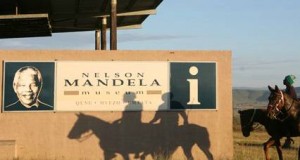Visitors are sometimes not sure where to find attractions specifically relating to Nelson Mandela. There are, however, a number of opportunities to learn more about his life and struggles by visiting destinations in various provinces which are connected with the famous ex-prisoner.

Nelson Mandela Museum in Mtata
In the Cape, a trip to Robben Island and the Robben Island Museum will shed some light on Nelson Mandela’s years in prison. Spend some time in his tiny cell and imbibe the atmosphere of this significant World Heritage Site.
There is also a statue of Nelson Mandela at the entrance to the Groot Drakenstein prison outside Paarl where he spent his last years in prison.
Visit the Nelson Mandela Youth and Heritage Centre at Qunu in the Eastern Cape and learn more about his youth and the missionary-run school that he attended. Also houses the exhibition (from the Mandela Museum in Mtata) which traces Nelson Mandela’s journey as told in his autobiography ‘A Long Walk To Freedom’.
Also in the Eastern Cape, the Voting Line metal statue at the Donkin Reserve in Port Elizabeth recalls South Africa’s first democratic poll – with a triumphant figure of Nelson Mandela at its head.
In Johannesburg you’ll find the Mandela House Museum at 8115 Vilakazi Street, Soweto where Nelson Mandela lived with his wife Winnie and their 2 children from the late 1940s onward. Nelson Mandela first stayed in the township of Alexandra when he first came to Johannesburg from the Eastern Cape and you can visit the one-room house on Stanley Road in Alexandra.
Constitution Hill in Braamfontein Johannesburg, the once notorious ‘Old Fort’ prison, housed many political prisoners – including Nelson Mandela, who was detained here during the 1956 Treason Trial. Once known as Liliesleaf Farm, this heritage site in Sandton, is closely linked to the Rivonia Treason Trial that led to Nelson Mandela’s incarceration.
The Nelson Mandela statue on Nelson Mandela Square in Sandton is a favorite place for tourists to have photographs taken with a gigantic Madiba.
Source: Nelson Mandela Museum





